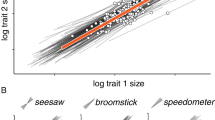Summary
Phenotypic variance for each of several bristle number characters (abdominal, sternopleural, second and third coxal) was partitioned using both hierarchal and dialled designs. Heritabilities and genetic correlations were estimated from parent-offspring regressions and correlations and half-sib correlations.
A high proportion of the genetic variance for abdominal bristle number was due to epistatic and sex-linked gene action, but most of the genetic variance for the other characters was additive autosomal.
The genetic correlations among sternopleural, and second and third coxal bristle numbers were all high, but that between abdominals and sternopleurals was low, while those between abdominals and either second or third coxals were virtually zero. An appreciable proportion of the covariance between abdominal and sternopleural bristle numbers was non-additive genetic.
The diallel method gave more reliable estimates of genetic parameters when non-additive or sex-linked genetic variation was present.
Zusammenfassung
Für eine Anzahl verschiedener Borstenzahl-Charaktere (abdominales, sternopleurales, 2. und 3. coxales Segment) wurde die phänotypische Varianz unter Verwendung hierarchischer und dialleler Versuchsanlagen unterteilt. Anhand von Elter-Nachkommen-Regressionen und-Korrelationen und von Halbgeschwister-Korrelationen wurden Heritabilitäten und genetische Korrelation geschätzt.
Ein hoher Anteil der genetischen Varianz für die Zahl abdominaler Borsten wurde durch epistatische Effekte und die Wirkung geschlechtsgekoppelter Gene bedingt. Bei den anderen Charakteren war der größte Anteil der genetischen Varianz additiv autosomal.
Die genetische Korrelation zwischen der Zahl der Borsten sternopleural und 2. und 3. Segment coxal war durchweg hoch, zwischen abdominal und sternopleural niedrig und zwischen abdominal und sowohl 2. und 3. coxal praktisch gleich null.
Ein bemerkenswerter Anteil der Covarianz zwischen der Zahl abdominaler und sternopleuraler Borsten war nicht-additiv genetisch.
Die Diallel-Methode ergab zuverlässigere Schätzungen der genetischen Parameter, wenn nicht-additive oder geschlechtsgebundene genetische Variation vorlag.
Similar content being viewed by others
Literature
Becker, W. A.: Manual of procedures in quantitative genetics. Pullman, Washington: Washington State University 1964.
Beilharz, R. G.: On the possibility that sex-chromosomes have a greater effect than autosomes on inheritance. J. Genetics58, 441–449 (1963).
Bohidar, N. R.: Derivation and estimation of variance and covariance components associated with covariance between relatives under sexlinked transmission. Biometrics20, 505–521 (1964).
Claringbold, P. J., andJ. S. F. Barker: The estimation of relative fitness ofDrosophila populations. J. Theoret. Biol.1, 190–203 (1961).
Clayton, G. A., J. A. Morris andA. Robertson: An experimental check on quantitative genetical theory I. Short-term responses to selection. J. Genetics55, 131–151 (1957).
Dawson, P. S.: Estimation of components of phenotypic variance for developmental rate inTribolium. Heredity20, 403–417 (1965).
Eisen, E. J. andJ. E. Legates: Genotype-sex interaction and the genetic correlation between the sexes for body weight inMus musculus. Genetics54, 611–623 (1966).
Falconer, D. S.: Introduction to quantitative genetics. Edinburgh-London: Oliver and Boyd 1960.
Frankham, R.: Studies in quantitative genetics and selection theory inDrosophila melanogaster. Ph.D. Thesis, University of Sydney (1967).
Griffing, B.: Accommodation of linkage in mass selection theory. Aust. J. Biol. Sci.13, 501–526 (1960).
Griffing, B.: Influence of sex on selection I. Contribution of sex-linked genes. Aust. J. Biol. Sci.18, 1157–1170 (1965).
Kearsey, M. J.: Biometrical analysis of a random mating population: a comparison of five experimental designs. Heredity20, 205–235 (1965).
Latter, B. D. H.: Selection for a threshold character inDrosophila I. An analysis of the phenotypic variance on the underlying scale. Genet. Res.5, 198–210 (1964).
Lerner, I. M.: Population genetics and animal improvement. Cambridge: Cambridge University Press 1950.
Lush, J. L.: Heritability of quantitative characters in farm animals. Proc. 8th Congr. Genetics (Hereditas Suppl.) 1949, 356–375.
Mode, C. J., andH. F. Robinson: Pleiotropism and the genetic variance and covariance. Biometrics15, 518–537 (1959).
Reeve, E. C. R.: The variance of the genetic correlation coefficient. Biometrics11, 357–374 (1955).
Reeve, E. C. R., andF. W. Robertson: Studies in quantitative inheritance. VI. Sternite chaeta number inDrosophila, a metameric quantitative character. Z. indukt. Abstamm.-u. Vererb Lehre86, 269–288 (1954).
Rendel, J. M.: Correlation between the number of scutellar and abdominal bristles inDrosophila melanogaster. Genetics48, 391–408 (1963).
Robertson, F. W.: Studies in quantitative inheritance. XI. Genetic and environmental correlation between body size and egg production inDrosophila melanogaster. J. Genetics55, 428–443 (1957).
Robertson, F. W.: Changing the relative size of the body parts ofDrosophila by selection. Genet. Res.3, 169–180 (1962).
Schaffer, H. E., andK. Kojima: Sex-linked inheritance of a quantitative trait ofDrosophila pseudoobscura. Genetics48, 775–786 (1963).
Sheldon, B. L.: Studies in artificial selection of quantitative characters I. Selection for abdominal bristles inDrosophila melanogaster. Aust. J. Biol. Sci.16, 490–515 (1963).
Spector, W. S. (Ed.): Handbook of Biological Data. Philadelphia: W. B. Saunders Company 1956.
Tallis, G. M.: Sampling errors of genetic correlation coefficients calculated from analyses of variance and covariance. Aust. J. Statistics1, 35–43 (1959).
Van Vleck, L. D., andC. R. Henderson: Empirical sampling estimates of genetic correlations. Biometrics17, 359–371 (1961).
Yule, G. U., andM. G. Kendall: An introduction to the theory of statistics. London: Charles Griffin and Company Limited 1950.
Author information
Authors and Affiliations
Rights and permissions
About this article
Cite this article
Sheridan, A.K., Frankham, R., Jones, L.P. et al. Partitioning of variance and estimation of genetic parameters for various bristle number characters ofDrosophila melanogaster . Theoret. Appl. Genetics 38, 179–187 (1968). https://doi.org/10.1007/BF00935264
Issue Date:
DOI: https://doi.org/10.1007/BF00935264




